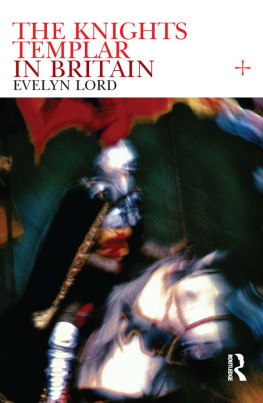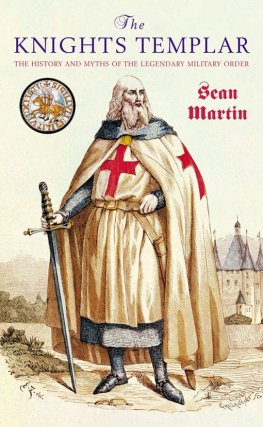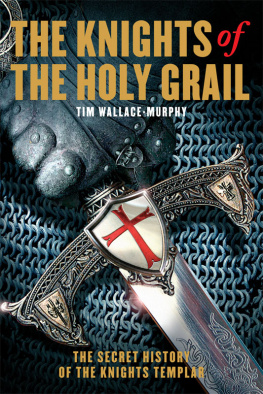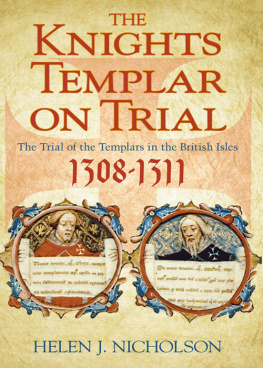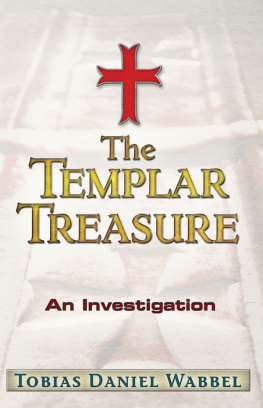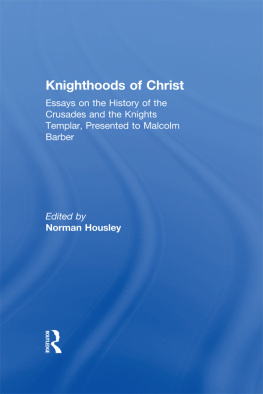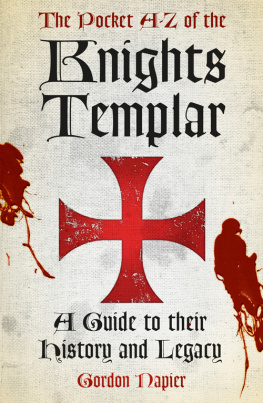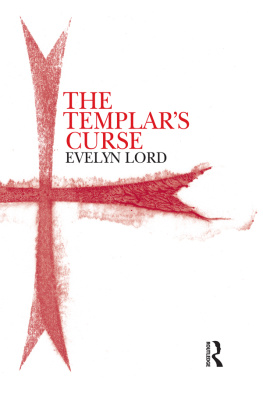THE KNIGHTS TEMPLAR IN BRITAIN
This book is dedicated to the memory of
Madeline and Rodney Howick, with love
THE KNIGHTS TEMPLAR IN BRITAIN
EVELYN LORD
First published 2002 by Pearson Education Limited
This paperback edition published 2004
Published 2013 by Routledge
2 Park Square, Milton Park, Abingdon, Oxon OX14 4RN
711 Third Avenue, New York, NY 10017, USA
Routledge is an imprint of the Taylor & Francis Group, an informa business
Copyright 2002, 2004, Taylor & Francis.
The right of Evelyn Lord to be identified as Author of this work has been asserted by her in accordance with the Copyright, Designs and Patents Act 1988.
All rights reserved. No part of this book may be reprinted or reproduced or utilised in any form or by any electronic, mechanical, or other means, now known or hereafter invented, including photocopying and recording, or in any information storage or retrieval system, without permission in writing from the publishers.
Notices
Knowledge and best practice in this field are constantly changing. As new research and experience broaden our understanding, changes in research methods, professional practices, or medical treatment may become necessary.
Practitioners and researchers must always rely on their own experience and knowledge in evaluating and using any information, methods, compounds, or experiments described herein. In using such information or methods they should be mindful of their own safety and the safety of others, including parties for whom they have a professional responsibility.
To the fullest extent of the law, neither the Publisher nor the authors, contributors, or editors, assume any liability for any injury and/or damage to persons or property as a matter of products liability, negligence or otherwise, or from any use or operation of any methods, products, instructions, or ideas contained in the material herein.
ISBN 13: 978-1-4058-0163-8 (pbk)
British Library Cataloguing in Publication Data
A CIP catalogue record for this book can be obtained from the British Library
Library of Congress Cataloging in Publication Data
A CIP catalog record for this book can be obtained from the Library of Congress
Typeset in 11/13.5pt Garamond by 35
CONTENTS
| BL | British Library |
| HMSO | Her/His Majesty's Stationery Office |
| NAS | National Archives of Scotland |
| NMR | National Monuments Record |
| RCHAMS | Royal Commission on Historical and Ancient Monuments for Scotland |
| RCHME | Royal Commission on Historical Monuments for England |
| RS | Roolls Series |
| SNL | Scottish National Library |
| TNA | The National Archives (formerly known as the Public Records Office) |
| VCH | Victoria County History |
Often the only evidence the historian has about the tenants living on the medieval manor is their names. An analysis of these can help to build up a picture of life on the manor and the people who farmed it. The surnames can be divided into locative names, those that refer to either a location outside the manor or a geographical feature within it, names that refer to a trade, names that show whose son the tenant was, tenants who are referred to only by their first names, and names that refer to some distinguishing feature of the individual such as Redhead or Whiteleg. The 1185 Inquest provides the names of a great number of Templar tenants, and in some cases these can be compared with later lists of tenants such as those found in The Hundred Rolls or the 1308 inventories.
Locative names can tell the historian whether the tenant has originated from elsewhere providing indirect evidence of spatial mobility. Trade names give information about the character of the manor or holding, such as whether there was a textile industry as well as farming carried on there, and can also give information on the type of trade and industry found in towns. Although in the preface to the 1185 Inquest Lees suggests that a tenant with a trade name did not necessarily follow that trade, McKinley's
Lees, B.A., (1935), Records of the Templars in the Twelfth Century, London: British Academy, xxviii, lxxxii; McKinley, R. (1990), A History of British Surnames, London: Longman, 131150.
I would like to acknowledge with gratitude the Board of Continuing Education of the University of Cambridge for arranging a sabbatical so that this book could be written, and all my colleagues at the Board. Members of Wolfson College for constructive criticism and conversation during the process of writing, and Professor Jonathan Riley-Smith of Emmanuel College for help and encouragement. The staff of Cambridge University Library, the Scottish National Library, the National Archives of Scotland, the National Archives, Kew, the Hertfordshire County Record Office, the Scottish Royal Commission on Historical and Ancient Monuments, the National Monuments Records in London, the library of Corpus Christi College, Cambridge, and the Usher Gallery, Lincoln, have all played their part in the completion of this project.
Especial thanks to Dr Joseph Elders of the Temple Dinsley Archaeological Project, to Mrs P. Willis and the staff of the Order of St John's Library and Museum, to Mr Philip Judge who drew the maps and plans from scraps of paper sent to him, and to Heather McCallum of Pearson Education.
Lastly, but by no means least, thanks to my family, who have supported me through this project. Gabriel Lord who assessed the cabalistic theories, Edward Lord who provided hospitality in Scotland and mended the central heating at a critical point in the creative process, and to Philip and Katie who listened.
Thanks to the following institutions for providing reproductions and permission to reproduce these: The British Library, .
The Knights Templar arrived in the British Isles in 1128 when Hugh de Payens, the first Grand Master, came to recruit crusaders. As well as acquiring manpower he was also given estates and manors. Eventually the Templars were to become major landholders in the British Isles. It is with them this book is concerned; with their churches, preceptories, farms and buildings, and their relationship with kings, princes, prelates and peasants.
Interwoven with the account of the Templars in the British Isles is their life as soldiers of the cross in the east. There have been many books describing their heroic exploits in the struggle to keep the Holy Land in Christian hands, but few have addressed their more mundane, but albeit necessary, role in the west of supplying money and resources for the fight in the east. This book aims to redress this by a comparative study of their lives as knights, monks, farmers, financiers and royal advisers in the British Isles. Using primary sources and excavation reports, it reconstructs the world of the British Templars. The result is an account of two hundred years of endeavour set against the background of political events and civil wars.
Central to the book are issues of concern to the historian of the Middle Ages, on the standard of living and diet, agriculture and the treatment of women. These are discussed within the context of the Templars' activities on land and sea, and the Templars are set firmly within the context of medieval society and their place in the local community. The book shows how the Order's influence on town and countryside has persisted in place-names, folklore and legends, and it discusses the colourful theories about the Order that these have produced.

